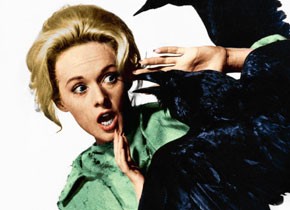Animals
A Brief Zoology of Cinema
October 16 to November 30, 2015
In the kingdom of cinema-creatures, the human animal sets the tone. It dominates the action, elevates itself above the other animals, delegates them to certain tasks, and never under any circumstance grants them access to the camera or the editing room. Thus, the cinema of ants (Phase IV), birds (Uccellacci e uccellini) and fish (Leviathan) always remains a cinema of humans – even though we often like to imagine how it would look the other way around (Planet of the Apes provides an uncomfortable glimpse).
Alongside the zoo, where similar power structures prevail, the cinema is the visual medium that most clearly marks the accelerated transition of Western societies into the age of "vanishing nature." In the late 19th and 20th centuries, animals gradually disappeared from the contexts of everyday life and work (as they did, successively, from the wilderness) only to reappear as pets, as capitalist kitsch, in the form of big-game trophies, or for that matter, as zoo or movie animals. Cultural studies have adequately shown how in that process animals were utilized and treated: somewhat differently than in the food or clothing industries but under the same ideological conditions.
This process of alienation in the modern age, as formulated by John Berger in his influential essay, "Why Look At Animals?", not only facilitated the increased systematic violence against animals, but also a new awareness of their suffering – from questions about their preservation and the dignity of animals to current debates about animal rights. Today, there is a hestitation with respect to animals, and the cinema (regardless of the strong anthropomorphism it has promoted in its depiction of animals) has no small role in this development. Because in the realm of photographic-cinematic images, the limits of the human viewpoint and of man’s centrality also become visible. As André Bazin has shown, the technology of cinema unfolds a world in which animals and things can exist independently from mankind – or on an equal basis with humans.
Which is why, to this day, animals in movies have preserved their sting, their vitality, their sometimes darkly provocative, sometimes enlightening power. Even more so if one looks beyond the globally dominant genres of animal cinema and TV (such as the wildlife documentary), focusing instead on the exceptional richness of those fictional, essayistic, experimental mirror images that independently minded human animals have created by looking at other animals. This is the universe that our "Brief Zoology of Cinema" attempts to trace: animals and their images look back at us. And show us (as constantly threatened animals/images) what our society and our forms of living together are all about, including some of the boundaries and illusions of humanity as such. In other cases, they lead us (as constantly threatening animals/images) into the realm of myth, monsters and mutants. Their precarious status is also our own.
From Étienne-Jules Marey’s proto-cinematic falling cat in the 1880s to Kelsey Goldych’s desktop-roaming Trash Cat of 2015; from Godzilla to Balthazar; from Winsor McCay's animated mosquito to Aardman Animations’ Creature Comforts; from Cocteau's man-beast through Truffaut's wolf-boy to the human lab-animals in Alain Resnais’ Mon oncle d’Amerique; from the red fox in works by Powell/Pressburger, Arne Sucksdorff and Wes Anderson to the sperm whale as seen by John Huston and Chris Marker: these are only a few of the many diverse arcs, connections, and zoological as well as film historical affinities and contrasts that characterize the fabric of this retrospective.
Its goal is not academic containment, but radical openness to a "crypto-zoological" wilderness: that of the cinema and its categories. As is triggers our curiosity, visual pleasure, reflexivity or sheer identification, it is often quite irrelevant whether the respective movie animal was trained or "caught in the act", invented or "real", effectively reproduced or just drawn with a few lines. All the more clearly, however, it can demonstrate to us how messy and impure the medium actually is: when the "documentary image" of a large herd of cows or buffalo stampedes across the screen in an elaborately constructed western – or when all roles in a studio-set narrative are played by live animals as in Jean Tourane's Une fée... pas comme les autres. Or the other way around, as in Battle at Kruger, when a shaky amateur camera on a safari records the most fantastically epic battle ever “staged” for a movie.
With its 140 selected works, this exhibition is as comprehensive as possible within a representational space that will always remain immeasurable. Because the "Lives of Others" which are being evoked here – between horror fables and screwball comedy, studies of society and thrillers, jungle dramas and Direct Cinema – amount in some ways to an allegory of cinema itself: an apparatus (“biograph”) which, for many film theorists, has functioned as a kind of Ersatz animal in the modern age. A machine in which animism, animation and animality all collaborate to create artifacts: lasting works of human culture. There is, of course, a much simpler and more fundamental way to put it, as Ludwig Wittgenstein did: "In all great art exists a wild animal: tamed."
Animals is this year’s joint retrospective of the Austrian Film Museum and the Viennale. We are grateful to the many individual and archival supporters of the program, in particular Elif Rongen and the EYE Film Institute, Amsterdam. A list of all films presented in the framework of the show can be found below.
Attention: Additional Screening of "The Birds" (1963, Alfred Hitchcock) in the presence of Tippi Hedren on October 31, 1 p.m.
